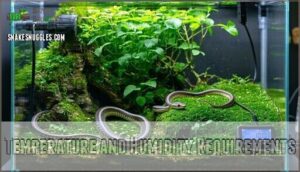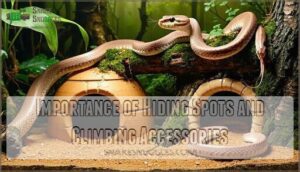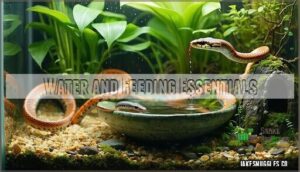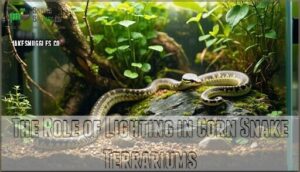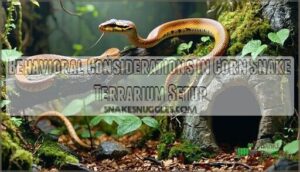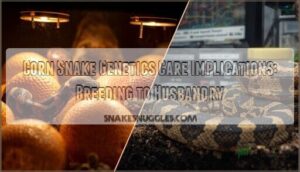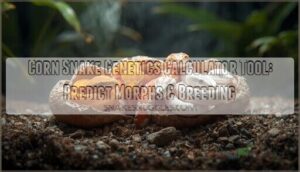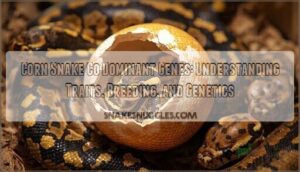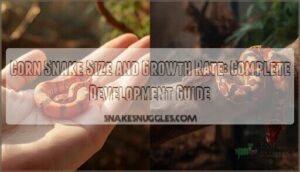This site is supported by our readers. We may earn a commission, at no cost to you, if you purchase through links.
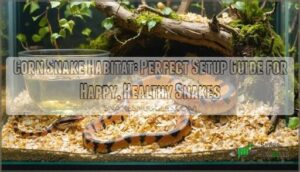
Set temperatures between 78-85°F on the warm side and 75-78°F on the cool side using under-tank heaters. You’ll want aspen shavings or cypress mulch for substrate since corn snakes love to burrow.
Add climbing branches and maintain 40-50% humidity with a water bowl. Think of it as creating a cozy woodland apartment – your snake needs privacy, proper climate control, and room to explore.
The secret lies in balancing security with enrichment opportunities that’ll keep your scaly roommate thriving.
Table Of Contents
- Key Takeaways
- Natural Habitat of Corn Snakes
- Enclosure Size and Design
- Ideal Substrate for Corn Snakes
- Temperature and Humidity Requirements
- Importance of Hiding Spots and Climbing Accessories
- Water and Feeding Essentials
- The Role of Lighting in Corn Snake Terrariums
- Behavioral Considerations in Corn Snake Terrarium Setup
- Frequently Asked Questions (FAQs)
- What is the best habitat for a corn snake?
- What do I need for a corn snake set up?
- What do corn snakes like in their cage?
- Do corn snakes need a basking light?
- Can corn snakes live together?
- How often should enclosures be cleaned?
- Do corn snakes need UVB lighting?
- How do I handle a corn snake?
- How often do corn snakes shed?
- How often should corn snake enclosures be cleaned?
- Conclusion
Key Takeaways
- You’ll need a minimum 40-gallon terrarium with proper temperature zones – maintain 78-85°F on the warm side and 75-78°F on the cool side using under-tank heaters and thermostats for consistent climate control.
- Choose aspen shavings or cypress mulch as substrate since your corn snake needs 2-3 inches depth for natural burrowing behavior, and these materials provide excellent tunneling opportunities without dust or toxicity concerns.
- Provide secure hiding spots on both warm and cool sides of the enclosure, plus sturdy climbing branches and cork bark tubes to support your snake’s natural climbing instincts and reduce stress.
- Maintain 40-50% humidity with a shallow water dish that’s changed weekly, and establish consistent 12-hour day/night lighting cycles to regulate your snake’s natural circadian rhythms.
Natural Habitat of Corn Snakes
Your corn snake’s natural habitat spans the southeastern United States, from New Jersey down to Florida and west to Louisiana.
These adaptable serpents thrive in remarkable habitat diversity – you’ll find them in pine forests, wetlands, rocky hillsides, and overgrown fields throughout their native range.
In the wild, corn snakes demonstrate fascinating wild behavior patterns.
They’re excellent climbers who hunt both on the ground and in trees, using their keen sense of smell to track rodents, birds, and eggs.
During winter, they brumate in hidden spots like rotting logs or underground burrows.
Interestingly, invasive populations have established themselves in places like Australia and the Caribbean, proving these snakes’ incredible adaptability.
Their vibrant colors provide camouflage in debris.
Understanding your snake’s natural southeastern United States origins helps you create the perfect captive environment, mimicking the complex microhabitats they’d naturally explore in forests and wetlands.
Enclosure Size and Design
Understanding your corn snake’s natural roaming patterns helps determine proper snake enclosure design.
Your adult corn snake needs a minimum 40-gallon tank with specific dimensions to thrive.
Tank dimensions should measure at least 3x2x2 feet, providing essential vertical space for climbing behaviors.
A larger enclosure can offer more enrichment, but it’s vital to recognize the minimum enclosure size for the snake’s age.
Consider these snake habitat requirements for ideal setup:
- Visual barriers using decorations to create secure zones
- Hiding variety with multiple shelter options throughout the habitat
- Enrichment items like branches supporting natural climbing instincts
Proper enclosure size and vertical height directly impact your snake’s well-being and activity levels.
Ideal Substrate for Corn Snakes
Now that you’ve got your enclosure sized perfectly, let’s talk about what goes on the bottom—your snake’s foundation for comfort and health.
Substrate cost shouldn’t break the bank, but cheap options can create problems. Aspen shavings top the list for snake bedding because they’re affordable, dust-free, and allow natural burrowing needs without abrasiveness concerns.
Your corn snake will tunnel through them like they’re exploring their childhood backyard. Cypress mulch works as another excellent substrate option, offering superior humidity control.
For moisture-retaining substrate needs, coconut coir blends beautifully with organic topsoil and play sand—think 60-30-10 ratio. Avoid cedar or pine shavings due to toxicity risks from aromatic oils.
Paper towels work temporarily but lack burrowing appeal. Consider cleaning frequency when choosing—aspen requires spot-cleaning and full changes every two weeks, while bioactive mixes last months.
Many retailers offer various aspen bedding options online. Your snake’s comfort depends on substrate depth of 2-3 inches for proper tunneling behavior.
Temperature and Humidity Requirements
Perfect substrate won’t matter if your temperatures are wrong.
The fanciest hide box won’t help if your thermal gradient is completely off track.
Your corn snake needs a thermal gradient with the basking spot reaching 85-90°F while the cool side stays 75-80°F.
Night temps can drop to 70-75°F safely.
Maintain humidity levels between 40-60% using a reliable hygrometer.
Poor humidity control causes shedding issues—too dry and your snake struggles with stuck shed.
Using reliable heat regulation is essential for corn snake well-being.
Use ceramic heat emitters and under-tank pads with digital thermostats for consistent temperature gradients that keep your snake healthy.
Importance of Hiding Spots and Climbing Accessories
Your snake enclosure needs both secure shelters and climbing branches to support natural behaviors.
Place hide boxes on warm and cool sides for stress reduction, using cork bark or ceramic caves sized appropriately for your snake.
Add sturdy branches and vines for climbing enrichment, as corn snakes are excellent climbers in the wild. Consider suitable climbing structures for their enclosure.
This habitat complexity with multiple hiding places and vertical structures creates a thriving environment. Strategic habitat setup with snake habitat decoration mimics their woodland origins, promoting both physical exercise and psychological well-being.
Water and Feeding Essentials
Your corn snake’s water source needs constant attention – think of it as their personal oasis.
Place a water dish that’s wide enough for complete soaking but shallow enough to prevent drowning.
Change this daily since stagnant water becomes a bacterial playground faster than you’d expect.
Feeding frequency matters more than you might think.
Juvenile snakes need meals every 5-7 days, while adults can wait 7-10 days between feedings.
Prey size should match your snake’s widest body section – no bigger than 1.5 times that width.
Frozen-thawed mice work best and won’t fight back like live prey.
Your snake’s diet doesn’t require supplementation needs when you’re feeding whole prey.
During shedding periods, shedding hydration becomes critical – that water dish doubles as a humidity booster.
Monitor your snake’s feeding habits closely; consistency keeps them healthy and content.
The Role of Lighting in Corn Snake Terrariums
After ensuring your corn snake has fresh water and proper nutrition, you’ll want to focus on creating the right lighting environment.
While corn snakes don’t require UVB lighting like some reptiles, proper illumination still plays an important role in their overall well-being.
Your lighting setup should accomplish several key goals:
- Heat Lamp Integration – Use basking lamps that work alongside your primary heat source to maintain the thermal gradient between 88-90°F on the warm side
- Light Cycles Management – Establish consistent 12-hour day/night cycles to regulate your snake’s natural circadian rhythms and reduce stress
- LED Options Selection – Choose energy-efficient LED lights that provide gentle illumination without adding excessive heat to the enclosure
- UVB Considerations – While optional, low-level UVB can support calcium metabolism and overall health when used appropriately
Remember, your corn snake’s lighting needs focus more on temperature regulation than intense illumination.
Behavioral Considerations in Corn Snake Terrarium Setup
You can’t just throw furniture into a room and expect your corn snake to feel at home—these naturally active climbers and burrowers need specific environmental features that match their wild behavior patterns.
Understanding your snake’s instinctive need to climb branches, hide in tight spaces, and experience natural day-night cycles will help you create a terrarium that promotes both physical health and psychological well-being, by considering their need to hide in tight spaces and their instinctive behavior as naturally active climbers.
Climbing Opportunities Provision
Avid climbers by nature, corn snakes thrive when you provide proper climbing branches and vertical enrichment.
Branch selection matters—choose sturdy pieces that won’t collapse under your snake’s weight.
Secure fixtures prevent dangerous falls, while vine placement creates natural pathways.
These climbing needs aren’t optional; they’re essential for mental stimulation and physical health.
| Climbing Feature | Enrichment Value |
|---|---|
| Natural branches | Mimics wild tree climbing behavior |
| Artificial vines | Safe, easy-to-clean climbing routes |
| Cork bark tubes | Dual hiding and climbing opportunities |
| Driftwood pieces | Textured surfaces for better grip |
| Bamboo poles | Lightweight yet sturdy climbing safety |
Burrowing Substrate Selection
Choosing the right substrate transforms your corn snake’s home into a natural paradise.
Quality bedding supports their instinctive burrowing behaviors while maintaining proper moisture levels and odor control.
Essential substrate considerations:
- Aspen shavings – excellent particle size for tunneling
- Cypress mulch – superior moisture retention properties
- Orchid bark – natural texture with good drainage
- Paper towels – hypoallergenic option for sensitive snakes
- ReptiChip – coconut-based substrate with ideal allergenicity profile
Day-Night Cycle Simulation
After selecting proper burrowing substrate, you’ll need to establish a proper day-night cycle using timers and gradual lighting changes.
Your corn snake’s activity patterns depend on consistent light cycles and temperature fluctuations.
Use a heat lamp with timer controls and monitor with a digital thermometer to create natural seasonal changes that support healthy feeding schedules.
| Day Period | Lighting & Temperature |
|---|---|
| Daytime (12 hours) | Full lighting, 88-90°F basking spot |
| Nighttime (12 hours) | Dim/no lighting, 72-75°F ambient |
| Seasonal Adjustment | Gradual changes mimic natural cycles |
Frequently Asked Questions (FAQs)
What is the best habitat for a corn snake?
Simple meets complex when creating your corn snake’s perfect home.
You’ll need a 40-gallon tank minimum with 88-90°F basking spots, 72-75°F cool areas, hiding places, climbing branches, and 40-50% humidity for ideal health.
What do I need for a corn snake set up?
You’ll need a 40-gallon tank, heat source for 88-90°F basking spot, substrate like aspen shavings.
Don’t forget climbing branches and proper ventilation for your snake’s comfort, hiding places, water dish, and thermometer.
What do corn snakes like in their cage?
Your corn snake craves hiding spots, climbing branches, proper heating gradients, and comfortable substrate for burrowing.
They’ll appreciate a water dish, thermal zones from 72-90°F, and visual barriers that make them feel secure and stimulated, with proper heating gradients being crucial for their well-being.
Do corn snakes need a basking light?
Like a sunbather craving warmth, your snake absolutely needs that basking light.
You’ll want to maintain 88-90°F on the warm side, creating a perfect thermal gradient that keeps your scaly friend healthy and happy.
Can corn snakes live together?
You shouldn’t house corn snakes together as they’re solitary creatures who prefer living alone.
Cohabitation increases stress, competition for resources, and cannibalism risks.
Each snake needs its own properly sized enclosure for ideal health.
How often should enclosures be cleaned?
Spot-clean your corn snake’s enclosure weekly by removing waste and soiled substrate.
Complete substrate changes should happen every 2-4 weeks, depending on substrate type.
Water bowls need cleaning and refilling weekly for superior health.
Do corn snakes need UVB lighting?
Unlike their sun-worshipping cousins, you don’t need UVB lighting for your corn snake.
They’re nocturnal hunters who thrive without it, though some keepers add low-level UVB believing it enhances natural behaviors and overall health.
How do I handle a corn snake?
Support your corn snake’s body gently but firmly, avoiding sudden movements.
Let them wrap around your hands naturally.
Start with short sessions, gradually increasing handling time as they become comfortable with you.
How often do corn snakes shed?
Corn snakes shed every 4-8 weeks, with juveniles shedding more frequently than adults due to rapid growth.
You’ll notice cloudy eyes and dull skin before shedding occurs, signaling it’s time for increased humidity.
How often should corn snake enclosures be cleaned?
Like keeping a tidy bedroom, you’ll want to spot-clean your corn snake’s enclosure weekly, removing waste and uneaten food. Do a complete substrate change and thorough cleaning every 4-6 weeks.
Conclusion
Picture your corn snake curled contentedly in its perfectly crafted home – that’s the reward of proper habitat setup.
You’ve learned that creating an ideal corn snake habitat requires attention to temperature gradients, appropriate substrate, secure hiding spots, and climbing opportunities.
Remember, consistency is key: maintain proper humidity levels, provide fresh water, and monitor environmental conditions regularly.
With these fundamentals in place, you’ll watch your serpentine companion thrive in an environment that mirrors its natural woodland home perfectly, ensuring a happy and healthy pet through proper habitat setup.
- https://www.iucnredlist.org/species/63863/71740603
- https://www.nsis.org/wildlife/wildlife-pr-rept.html
- https://www.reptilecentre.com/pages/info-corn-snake-care-sheet
- https://www.zenhabitats.com/blogs/reptile-care-sheets-resources/corn-snake-general-reptile-care-guide-reptifiles?srsltid=AfmBOooNl7Xdw8UG8AtKC1EhwzfxDQJq4CoDDqCfDjsycTluIMNjl_8a
- https://community.morphmarket.com/t/corn-snake-care-guide/39834

